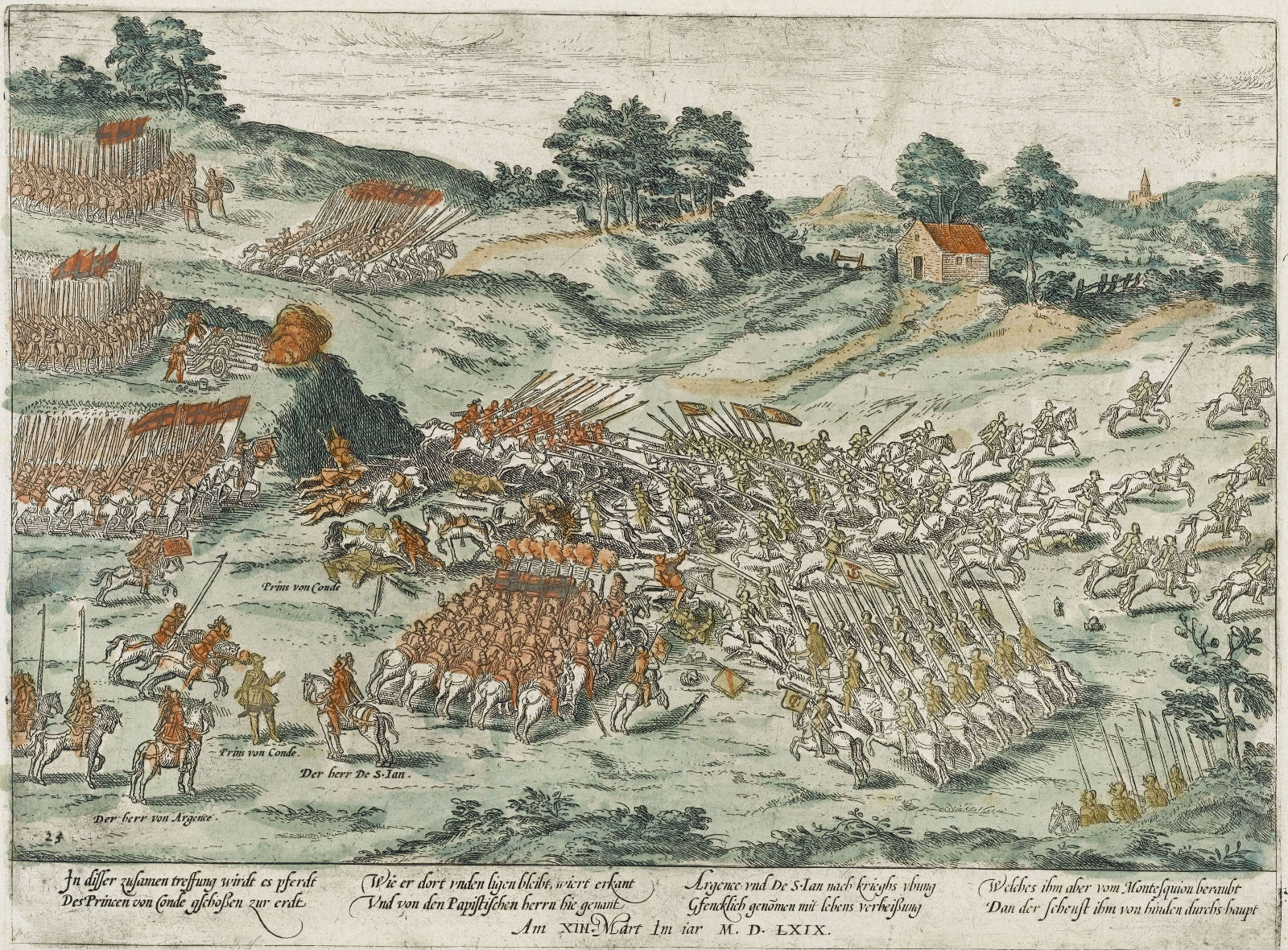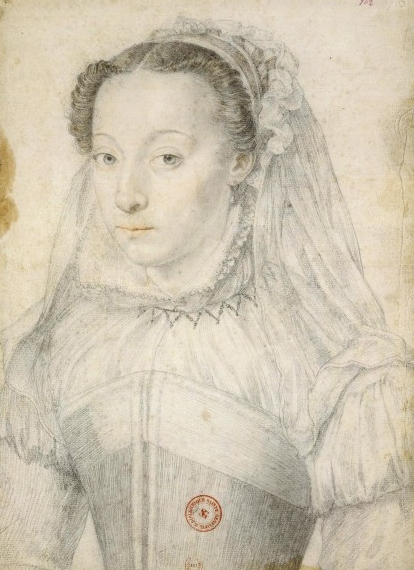|
Françoise D'Orléans-Longueville
Françoise d'Orléans-Longueville, Princess of Condé (5 April 1549 – 11 June 1601) was the second wife of Louis de Bourbon, Prince of Condé, a " Prince du Sang" and leader of the Huguenots during the French Wars of Religion. Family Her paternal grandparents were Louis d'Orléans, Duke of Longueville, Sovereign Count of Neuchâtel, Prince of Chatel-Aillon, and Princess Johanna of Baden-Hachberg, Sovereign Countess of Neuchâtel and Margravine of Rothelin, and her maternal grandparents were Charles de Rohan, Viscount of Fronsac and Jeanne de Saint-Séverin. Françoise had an older brother, Leonor, Duke of Longueville, Duke of Estouteville, and Prince du Sang (1540–1573), who married, in 1563, Marie de Bourbon, Duchess d'Estouteville (1539–1601), by whom he had issue, including Henri I, himself later Duke of Longueville. Françoise's cousin, François III d'Orléans, Duke of Longueville was the uterine half-brother of Mary, Queen of Scots. Her maternal aunt, Claude de ... [...More Info...] [...Related Items...] OR: [Wikipedia] [Google] [Baidu] |
Princess Of Condé
The title Princess of Condé refers to the wife of the Prince of Condé, a noble title in France. The House of Condé is a cadet branch of the House of Bourbon, which played a significant role in French history. Princess of Condé See also *Duchess of Bourbon *Duchess of Guise *Duchess of Enghien *Duchess of Montmorency References {{DEFAULTSORT:Princess Of Conde House of Bourbon-Condé, Princesses of Conde House of Bourbon, Conde, princesses of Princesses of Condé, Lists of French nobility, Conde, princesses of Princes of Condé, Princesses of Conde Princesses of France (Bourbon) Lists of princesses ... [...More Info...] [...Related Items...] OR: [Wikipedia] [Google] [Baidu] |
Duke Of Longueville
Duke of Longueville (''Longueville-sur-Scie'') was a title of French nobility, though not a peerage of France. History The title was created in 1505 by Louis XII of France, King Louis XII of France for his first cousin once removed, François d'Orléans, Count of Dunois, son of François d'Orléans, Count of Dunois, son of Jean de Dunois, Jean d'Orléans, himself an illegitimate son of the Louis de Valois, duc d'Orléans, Duke of Orléans. The title became extinct in 1694, following the death of Jean Louis Charles d'Orléans, who was the brother of Marie de Nemours. From 1648, the Duke of Longueville was also Principality of Neuchâtel, Sovereign Prince of Neuchâtel, a Switzerland, Swiss territory. In 1654, the eighth duke was created a peer of France, peer as Duke of Coulommiers, but the peerage was never registered and so became extinct at his death. Dukes of Longueville # François II, Duke of Longueville, François II (1478–1513). # Louis I d'Orléans, duc de Longueville, ... [...More Info...] [...Related Items...] OR: [Wikipedia] [Google] [Baidu] |
Battle Of Jarnac
The Battle of Jarnac on 13 March 1569 was an encounter during the French Wars of Religion between the Catholic forces of Marshal Gaspard de Saulx, sieur de Tavannes, and the Huguenots led by Louis I de Bourbon, prince de Condé. The two forces met outside Jarnac between the right bank of the Charente and the high road between Angoulême and Cognac. The Huguenots were routed and Condé was killed after his surrender and his body paraded on an ass in Jarnac. Prelude In late 1568 the Huguenot and Royal armies both circled Loudun seeking to find good ground to attack the other, but terrible weather scuppered these attempts. The Royal army broke off towards Chinon to make camp, whilst the Huguenot forces tried and failed to take Saumur before likewise settling into camp. Hearing the Huguenot forces intended to break south towards Cognac, Marshal Gaspard de Tavannes, superior in cavalry, crossed the Charente by the bridge at Châteauneuf on the night of 12 March. With him were 270 ... [...More Info...] [...Related Items...] OR: [Wikipedia] [Google] [Baidu] |
Escadron Volant
Escadron volant (" heFlying squadron") was a term used in the propaganda against the queen-regent of France, Catherine de' Medici. It was a part of the Black Legend around Catherine de' Medici, alongside her alleged use of poison, witchcraft and political conspiracies. The term stood for the beautiful ladies-in-waiting of the queen dowager, whom she is claimed to have specifically employed in order to use them as spies to further her political agenda by exploiting their beauty and sexuality. History The French Huguenot Protestants referred to these ladies-in-waiting as "a stable of whores", who where prostituted by the queen-regent to further her political goals, and used it as an example of the decadence of the Catholic House of Valois. The historical truth of the term is dubious. Queen Catherine de' Medici is known to have employed a famously large number of ladies-in-waiting; a larger number than most French queens. It was not uncommon for women of the royal court to have ... [...More Info...] [...Related Items...] OR: [Wikipedia] [Google] [Baidu] |
Catherine De' Medici
Catherine de' Medici (, ; , ; 13 April 1519 – 5 January 1589) was an Italian Republic of Florence, Florentine noblewoman of the Medici family and Queen of France from 1547 to 1559 by marriage to Henry II of France, King Henry II. She was the mother of French kings Francis II of France, Francis II, Charles IX of France, Charles IX, and Henry III of France, Henry III. She was a cousin of Pope Clement VII. The years during which her sons reigned have been called "the age of Catherine de' Medici" since she had extensive, albeit at times varying, influence on the political life of France. Catherine was born in Florence to Lorenzo de' Medici, Duke of Urbino, and Madeleine de La Tour d'Auvergne. In 1533, at the age of 14, Catherine married Henry, the second son of King Francis I of France, Francis I and Queen Claude of France, who would become Dauphin of France (heir to the throne) upon the death of his elder brother Francis III, Duke of Brittany, F ... [...More Info...] [...Related Items...] OR: [Wikipedia] [Google] [Baidu] |
Isabelle De Limeuil
Isabelle de la Tour, Lady of Limeuil (c. 1535 – 25 March 1609) was a French noblewoman and a Maid of Honour to the Queen Mother Catherine de' Medici. She also formed part of Catherine's notorious " flying squadron" (''L'escadron volant''), a group of beautiful female spies she used for the purpose of forming sexual liaisons with various powerful men at the French court thereby extracting information which would then be passed on to her. In about 1562 at Catherine's instigation, she became the mistress of Louis, Prince of Condé, brother of King Antoine of Navarre and one of the leading Huguenots in France. Two years later when Isabelle created a scandal by giving birth to his son whilst the court was on a royal progress, she was banished to a convent. She later married wealthy Tuscan banker Scipion Sardini, a favoured protégé of Catherine de' Medici. Family Isabelle was born in Limeuil, France in about 1535, a daughter of Gilles de la Tour, Viscount of Turenne, Baron of ... [...More Info...] [...Related Items...] OR: [Wikipedia] [Google] [Baidu] |
Jeanne D'Albret
Jeanne d'Albret (, Basque language, Basque: ''Joana Albretekoa''; Occitan language, Occitan: ''Joana de Labrit''; 16 November 1528 – 9 June 1572), also known as Jeanne III, was Queen of Navarre from 1555 to 1572. Jeanne was the daughter of Henry II of Navarre and Margaret of Angoulême (and thus the niece of Francis I of France). In 1541, she married William, Duke of Jülich-Cleves-Berg. The marriage was annulled in 1545. Jeanne married a second time in 1548, to Antoine de Bourbon, Duke of Vendôme. They had two surviving children, Henry IV of France, Henry and Catherine de Bourbon, Catherine. When her father died in 1555, Jeanne and Antoine ascended the Navarrese throne. They reigned as joint rulers until Antoine died in 1562 from wounds suffered while besieging Protestant-held Rouen during the French Wars of Religion. After her public conversion to Calvinism in 1560 however, Jeanne, on the other hand, had become the acknowledged spiritual and political leader of the French ... [...More Info...] [...Related Items...] OR: [Wikipedia] [Google] [Baidu] |
Antoine Of Navarre
Antoine (, , 22 April 1518 – 17 November 1562), sometimes called Antoine of Bourbon, was King of Navarre from 1555 until his death in 1562 as the husband and co-ruler of Queen Jeanne III. He was the first monarch of the House of Bourbon, of which he became head in 1537. Despite being Prince du sang#Monsieur le Prince, first prince of the blood in France, Navarre lacked political influence and was dominated by King Henry II of France's favourites, the House of Montmorency, Montmorency and House of Guise, Guise families. When Henry II died in 1559, Navarre found himself sidelined in the Guise-dominated government, and then compromised by his brother's treason. When Henry's son, King Francis II of France, soon died in turn, Navarre returned to the centre of politics, becoming Lieutenant-General of France and leading the army of the crown in the first of the French Wars of Religion. He died of wounds sustained during the Siege of Rouen (1562), Siege of Rouen. He was the father of Kin ... [...More Info...] [...Related Items...] OR: [Wikipedia] [Google] [Baidu] |
Louis, Prince Of Condé (1530–1569)
Louis, Prince of Condé may refer to: * Louis, Prince of Condé (1530–1569), Huguenot leader and general * Louis, Prince of Condé (1621–1686) * Louis, Prince of Condé (1668–1710) {{disambiguation, tndis ... [...More Info...] [...Related Items...] OR: [Wikipedia] [Google] [Baidu] |
Vendôme
Vendôme (, ) is a Subprefectures in France, subprefecture of the Departments of France, department of Loir-et-Cher, France. It is also the department's third-biggest Communes of France, commune with 15,856 inhabitants (2019). It is one of the main towns along the river Loir. The river divides itself at the entrance of Vendôme, intersecting it into numerous different arms. The town has a rich Middle Ages, medieval history and many historical monuments. History Vendôme (in ) appears originally to have been a Gaul, Gallic , replaced later by a feudal castle, around which the modern town arose. Christianity was introduced by in the 5th century, and the important abbey of the Trinity (which claimed to possess a tear shed by Jesus at the tomb of Lazarus of Bethany, Lazarus) was founded about 1030. When the reign of the House of Capet began, Vendôme formed the chief town of a county belonging to Bouchard, called "the Venerable", who died in the monastery of in 1007. The succ ... [...More Info...] [...Related Items...] OR: [Wikipedia] [Google] [Baidu] |
Francis I Of France
Francis I (; ; 12 September 1494 – 31 March 1547) was King of France from 1515 until his death in 1547. He was the son of Charles, Count of Angoulême, and Louise of Savoy. He succeeded his first cousin once removed and father-in-law Louis XII, who died without a legitimate son. A prodigious patron of the arts, Francis promoted the emergent French Renaissance by attracting many Italian artists to work for him, including Leonardo da Vinci, who brought the ''Mona Lisa'', which Francis had acquired. Francis's reign saw important cultural changes with the growth of central power in France, the spread of humanism and Protestantism, and the beginning of French exploration of the New World. Jacques Cartier and others claimed lands in the Americas for France and paved the way for the expansion of the first French colonial empire. For his role in the development and promotion of the French language, Francis became known as (the 'Father and Restorer of Letters'). He was also known ... [...More Info...] [...Related Items...] OR: [Wikipedia] [Google] [Baidu] |







